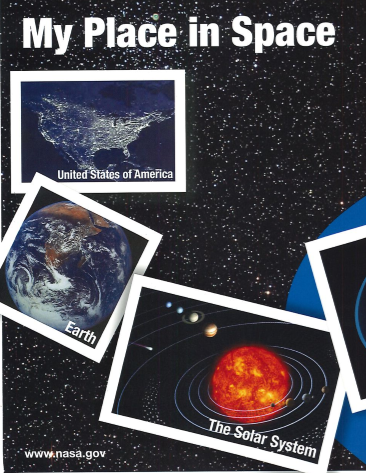Night: A Time for Dreams and Dreamers
Before light pollution hid many of the stars and other objects, the night sky inspired people to wonder and dream, create art and stories, and also helped them travel across the globe. For astronomers, enthusiasts, and casual viewers of the night sky, the stars continue to inspire people to dream big and stay curious. Without a dark night sky, we wouldn't have works of art like Vincent van Gogh’s Starry Night, sent missions into space, or even have the Discovery Center. Thankfully, humankind has had a long relationship with the stars and has used them to travel, express themselves, and tell their stories. What do you love most about spending time under the night sky?
Virtual Storytime: The Reason for the Seasons
This Saturday marks the beginning of summer in the Northern Hemisphere—and this week’s distance learning theme is seasons. Join one of our museum educators as she learns what causes these periodic changes in Earth’s conditions by reading The Reason for the Seasons, written and illustrated by Ellie Peterson!
Virtual Storytime: The Story of Space--A first book about our universe
This week’s distance learning theme is planets. Join one of our museum educators as she reads about the planets in our solar system—and so much more—in The Story of Space by Catherine Barr and Steve Williams, illustrated by Amy Husband!
Virtual Storytime: The Big Dipper
Today, we continue our Vacation Week theme of “deserted island” with a story about navigation and wayfinding. Join one of our museum educators as she reads the Scholastic children’s book The Big Dipper by Franklyn M. Branley, with illustrations by Molly Coxe!
Virtual Storytime: There Once Was a Sky Full of Stars
Join one of our museum educators as she reads the children’s book There Once Was a Sky Full of Stars by Bob Crelin, with illustrations by Amie Ziner!
Space Crafts: Comet on a Stick
Make your own celestial “dirty snowball” with common household materials!
a simple all-ages activity
Just for Fun: Interstellar Postcard
Have you ever traveled far away from home? Did you send a postcard to your friends or family to share the experience with them? Let your imagination take you on a trip faaaaar from Earth, at the very boundaries of our solar system—what might THAT postcard look like?!
Open-ended all-ages activity, courtesy of NASA.
Distance Learning Module: Weather, Weather Everywhere: Part II (Other Planets)
Weather: it’s more than just a conversation-starter.
What causes weather, how do we study it, and what is the weather like on other planets? Learn all about it in today’s lesson, geared toward middle-school learners! Part 2 of 2.
Distance Learning Module: Weather, Weather Everywhere: Part I (Earth)
Weather: it’s more than just a conversation-starter.
What causes weather, how do we study it, and what is the weather like on other planets? Learn all about it in today’s lesson, geared toward middle-school learners!
At-Home STEM Activities: Calculate the Diameter of the Moon
Formulate the diameter of the moon using proportions.
This activity is geared toward middle- and high schoolers due to the mathematical component.
Distance Learning Module: Cosmic Dust
Bid “happy retirement” to the Spitzer Space Telescope in this lesson all about an underappreciated substance in space (and our homes): DUST!
Includes activities appropriate for grade levels K-2 and 3-5
Distance Learning Module: Observational Data/Night Sky Journal
Hone your hands-on science skills by recording astronomical data from home
Need an enriching activity for the whole family? This ongoing project can be completed as a group! Build skills in observation, astronomical understanding, writing, sketching/fine motor skills, and more by creating a Night Sky Journal of observational fieldnotes.
Can be modified to incorporate various age/grade/skill levels.
Distance Learning Module: The Challenges of Space Travel
As NASA and others talk about more, longer trips to the Moon and plans for a mission to Mars, we have to consider the hostile environments we’ll encounter and the limits on our equipment. What qualities and technological capabilities will astronauts need in order to make those journeys?
In this lesson, adapted from our 2020 Term 3 Homeschool Workshop, we practice critical thinking, analysis, and discussion skills, and ask ourselves: what does it mean to do something not in spite of it being hard, but because it is hard?
Geared toward grades 6-8.
At-Home STEM Activities: Hole-Punch Earth
Create a scale model of the Earth and Sun with craft supplies in your own home!
This activity is a hands-on lesson in proportions, scale, and relative sizes in the solar system.
Geared toward middle- and high schoolers due to the mathematical component.
Distance Learning Module: Stars and Sun
Get to know the stars…including one very special star in particular!
Geared toward pre-K and lower-elementary level students.
Distance Learning Module: Seasons and Equinoxes
In this timely multimedia lesson, we explore what causes Earth’s seasons, and what it means to experience an equinox.
Geared toward upper elementary-level students.
At-home STEM Activities: Constellation Cards
The Discovery Center’s mission is to inspire every generation to reach for the stars, through engaging, artful and entertaining activities that explore astronomy, aviation, earth and space science. So while were closed and while our visitors are finding the best ways to learn at a distance, we’ll be posting some activities here with the goal of helping to enrich kids’ education at home.


















